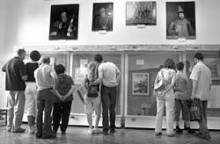Summer is a dead season with closed concert halls and drama theaters. Many tourists visit the Ukrainian capital to marvel at Kyiv’s ancient and modern landmarks. The Day asked some museum employees for their thoughts on the most evocative exhibits this summer and the visitors who explored our museums.
Nina KOSTANIUK, history specialist, National Museum of Ukrainian History:
We are constantly organizing very interesting exhibits, including the current one, “Simon Petliura: Pages from His Political Biography (1879-1926), commemorating the 80th anniversary of his death. Besides thematic shows, there is a permanent exhibit called “The Colors of Art Glass,” featuring works by craftsmen from the Art Glass Workshop. Our visitors were drawn to Zinaida Zraziuk’s work. We get a lot of Kyiv residents and Ukrainian tourists, especially visitors from the western oblasts. They are generally interested in famous Ukrainian personalities, like Bohdan Khmelnytsky, Ivan Mazepa, and others; they want to learn more about Kyivan Rus’. Friends of our museum realize that knowledge of history will help them avoid a number of mistakes in the modern historical context.
Natalia IVANOVA, art critic, National Museum of Ukrainian Literature:
The following exhibits were extremely popular: “Franko and Kyiv (commemorating the 150th anniversary of Ivan Franko’s birth); “Love Ukraine” (pegged to Independence Day); “Ukraine as Seen through Children’s Eyes” (marking International Children’s Day). Not surprisingly, schoolchildren, high school graduates, and university students are frequent visitors.
Roman TACHAN, deputy head of the National Kyivan Cave Historical- Cultural Preserve:
Our preserve does not hold temporary exhibits, we only have permanent displays. We offer various tours that are extremely popular with Ukrainians visiting from various regions, as well as foreign tourists. The most popular one is the “Lavra Treasure Trove: Monuments of 17th - 20th-Century Sacred Art” (part of the preserve’s collection); also “The Lavra Caves: History, Archaeology, and Architecture” (the Platar Collection of Antiquities). Visitors from abroad are invariably interested in the history of the Kyivan Cave Monastery and are enchanted their guides’ stories. Since this is a unique historical-cultural preserve, the buildings on its territory are on the list of the world’s oldest architectural monuments. It is gratifying to know that European tourists are becoming more interested in our country.
Hanna PEREKHODKO, Senior Research Fellow, National Art Museum of Ukraine:
Our museum was closed for a long time this summer (from June 18, after the exhibits of paintings by Roman Zhuk and Volodymyr Patyk, and graphics by Andriy Chebykin). But this did not dampen the success of our most recent exhibit, “New Contributions,” commemorating the 15th anniversary of Ukrainian independence. This one mainly featured works contributed by well-known artists. If you brows the visitors’ book, you will see many entries by Kyiv residents and many tourists conveying their heartfelt appreciation. By the way, a permanent exhibit of icons and painting was recently established on the ground floor of our museum. Among its oldest items is a 12th-century icon. The exposition culminates with a 19th-century landscape. In the last while, most our visitors have shown an interest in realist works of art; people must have become tired of all those postmodernistic “broken” worlds. I should point out that the museum staff nostalgically recalls an exhibit held in the spring: the works of Niko Pirosmani, the renowned Georgian naive artist. There were so many visitors eager to explore the legendary Pirsomani’s works that there were long lines at the entrance to the museum for the duration of the exhibit. It attracted sensational public interest, which is further proof that Ukrainians can appreciate true works of art.
Iryna POPOVA, staff member, Kyiv History Museum:
This summer, residents of Kyiv and guests to our capital were most interested in exploring an exhibit called “Your Children, Ukraine,” by Leonid Levit, and “My Kyiv” by Volodymyr Marchuk. We hope that our next exhibit, Kateryna Krychevska-Rosandych’s personal collection commemorating the 80 1 anniversary of her birth, which is scheduled to open Sept. 7, will attract considerable public interest.
Natalia KORNIIENKO, art historian, Bohdan and Varvara Khanenko Museum:
The best visitors’ comments are on the exhibit “The Art of Greece, Etruria, and Rome” (part of the museum collection), as well as a private collection entitled LLADRO: Porcelain Art.” I have to say that our museum is quite popular. Foreign tourists are showing a keen interest in our displays, and we have quite a few local visitors.
Maia CHUMAK, tourist guide, Museum of Outstanding Ukrainian Cultural Personalities:
All summer we had an exhibit called “Glass Icons,” featuring works by Oleksandr Kovalchuk, a unique master from Vinnytsia oblast. This artist uses an ancient painting technique. Placing glass on a picture and then repainting it may appear to be a simple procedure. But it is more than just copying, and this artist has proved that genuine talent works with real inspiration; his work may be compared to precious gems set among the most skillfully made counterfeits. Our museum’s exhibit of applied “patchwork” art by Nadia Yakovenko is also very popular, as well as an exhibit of children’s work devoted to a poetry competition. Following requests from our visitors, we have focused our main attention on exhibits of applied folk art.








